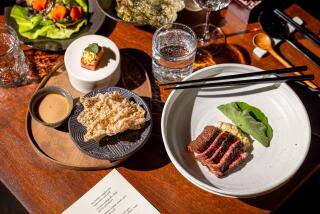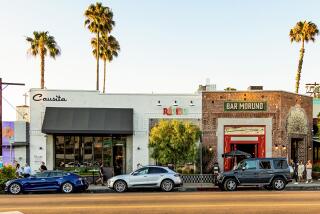Upscale restaurants are dressing down
Water Grill, with its attentive servers, white tablecloths and hushed formality, was long a stalwart of L.A.’s old-guard restaurant scene.
But to the young professionals who have streamed into its downtown neighborhood, all that pomp — and closing times as early as 9 p.m. — were just a bit too grandpa.
To attract those budding foodies, Water Grill recently completed a $1.5-million makeover. The decor is more casual, the menu less expensive and filled with craft brews favored by the hipster crowd. Doors often stay open past midnight. Pop music and flat-screen TVs have supplanted whispered conversations.
The result: Revenue is up 40% in recent months compared with the same period last year, even though the average check has fallen 20% to about $65, said Sam King, chief executive of King’s Seafood Co., the parent of Water Grill.
King admits the new vibe may not suit some longtime patrons. “We’ll probably lose a portion of our base because we’re not as quiet anymore,” he said. But “we have to compete.”
Upscale restaurants, which have long catered to the gray-templed, expense-account set, are courting younger diners to pay the bills.
The Great Recession pummeled the U.S. restaurant industry, as diners traded down or ate at home. Even patrons who could afford a fancy meal celebrated less ostentatiously amid the new austerity. Businesses slashed entertainment and travel budgets and have kept a lid on spending even as the economy improves.
To compensate, upscale eateries are trying to fill their seats with younger diners. Although not as flush as their elders, they tend to cook less and eat out more often, according to the National Restaurant Assn. People under age 25 spend nearly 48% of their food budgets eating away from home, compared with 42% for the average American.
They’re also more adventurous eaters, favoring small plates and lively venues over dark wood and candlelight.
“The way America is choosing to dine is changing dramatically because the demographics are changing,” said Gary Levy, who works with hospitality clients for consultant firm J.H. Cohn.
The shift can be seen in downtown Los Angeles, whose population jumped 50% between 2000 and 2010 to almost 39,000 residents, according to census data. And many of those newcomers are young. The fastest-growing group of downtown residents, with a 79% increase over the decade, is made up of 18- to 29-year-olds. The median age is 32.5, according to the Downtown Center Business Improvement District.
“We saw a whole new thing downtown — a lot more [Generation] Xs and Ys,” King said.
Social media has changed the landscape as well. Younger diners armed with smartphones are linked via Twitter, Facebook, Chowhound and Yelp into a vast online foodie network. They have the power to bestow must-visit status on any restaurant or condemn it as hopelessly unhip — within a matter of days.
Take Santa Monica consultant Tessa Chiueh, 39. She eats out two or three times a week with her husband and eagerly posts her opinions on the review site Yelp.
A recent visit to Spago Beverly Hills, Wolfgang Puck’s posh eatery, left her underwhelmed. The food was decent — albeit expensive, she wrote in an online review. But, she said, the decor was “definitely from the ‘80s or early ‘90s” and the drinks were “in serious need of a proper mixologist.”
Interviewed by phone, she said she wouldn’t go back “unless it’s for a meal where I’m not paying.”
Puck appears to have gotten the message. This summer, Spago is set to close for several months for an overhaul of its decor and menu.
Another pricey legacy restaurant, Laurel, underwent its own transformation mid-recession.
Located in San Diego’s Bankers Hill district, the French restaurant packed them in during the height of the housing boom, serving up “tweezer food” such as elk loin sous-vide for $39, according to marketing director Mike Rutherford. But once the real estate bubble burst, the 120-seat dining room hosted only 50 diners on a good night.
The owners decided on a complete overhaul. They shut Laurel, rehabilitated the entire space in five weeks and reopened in the summer of 2009 as the more casual Cucina Urbana serving rustic Italian food.
The restaurant, once a “very formal, pristine environment” is now “very crowded, very loud, very energized,” Rutherford said.
Cucina Urbana diners are younger and spend less; the average check is $34, compared with $55 at Laurel. But these patrons come in more often. The 144-seat restaurant serves as many as 450 customers nightly and has added lunch service.
“It was a pretty stark transition,” Rutherford said. “But smart restaurateurs need to adapt.”
In West Hollywood, Petrossian, a restaurant started by a Parisian caviar company, needed to hook a new generation on the salty delicacy. So its management launched Caviar 101.
Two days a month, guests can get a flute of Champagne or a shot of icy vodka, appetizers and samples of at least five caviars, all for $35. The deal was so popular that in October, the restaurant added pricier Caviar 201 and 301 tastings.
“People are coming in for the first time and finding that this isn’t the stuffy restaurant they thought it would be,” said Petrossian spokeswoman Trisha Cole.
Stuffiness is such a turnoff for younger diners that upscale, trendy Beverly Hills eatery Crustacean recently loosened its dress code and began offering a cheaper, faster lunchtime service. It also hired a bar mixologist and added occasional happy hour events with DJs.
“Dining is not about eating — it’s an experience,” said owner Elizabeth An. “People are moving away from very formal fine dining. Dinner is spontaneous now.”
Young diners tend to want to share plates with friends. To accommodate them, Water Grill’s menu is now heavier on appetizers so diners can sample multiple dishes.
Sunny Kwon, 40, says the strategy is working. In the past, the downtown resident dined at Water Grill only for business lunches or special occasions with her parents.
She revisited Water Grill recently and was impressed by the relaxed atmosphere and the absence of “old money bags” customers. The tablecloths were gone and the floors stripped of carpet. French fries, mashed potatoes and macaroni and cheese were on the menu.
“I didn’t used to think of it as an everyday type of dining experience,” said Kwon, a production manager for a clothing maker. “We like things to be more casual — sitting at the bar, having a couple of drinks with our meal. That’s why it was freakin’ fantastic that they did this.”







